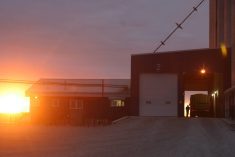You are driving on a grid road 30 kilometres from home and come across an accident.
Is it better to do what you can for the injured before driving home and calling 911, or put the person in your truck and rush him to the nearest hospital?
Two people trained in emergency response say it depends.
Tim Hillier, a paramedic for 17 years with Saskatoon’s MD Ambulance, told a Nov. 28 farm injury control conference that the person first on the scene will hopefully have had safety training and will ultimately decide what to do based on the facts.
Read Also

VIDEO: Bittersweet harvest for this family farmhand
Bruce Burnett helps his brother harvest wheat and canola for the last time on the family farm in Manitoba where they both grew up.
Instructor Patricia Lundy said “once you take the farm response course, you’ll do whatever is best for you at that time and live with your decision later.”
Both said it is difficult to provide medical care while driving a vehicle.
However, a nurse in the audience said the best answer can sometimes be a combination of alerting the nearest hospital that an emergency case is coming and driving the person to meet the ambulance.
Hillier has been training people how to be first responders since 1986. The 40-hour program is based on an American course. There are now 1,700 first responders trained in the province. They are mainly in rural areas and are all tied to the health districts. They can be called out of bed at 3 a.m. on a winter’s night to the scene of a highway accident or to someone’s house to help injured people until the ambulance arrives.
Hillier said the program is based on the realities of Saskatchewan health care and the distances from services in rural and northern areas.
“In Saskatoon, we (ambulance) have to report any situation where we took longer than eight minutes (to arrive). In rural areas it can take 40 minutes.”
Lundy said a coalition of rural municipalities and the Centre for Agricultural Medicine developed the course she teaches because farm accidents kill 26 Saskatchewan farmers a year and hospitalize another 328.
Family members are often the first to find the injured person and don’t know what to do, including how to shut off the tractor, how to deal with bleeding and who to call for help. The goals are to keep the injured person and the rescuer safe and to contact emergency services for help.
The 911 phone system is available in most Canadian cities, and every province is working on extending it to rural areas.
It will be another year before 911 covers all of Saskatchewan. Doug Line, who is working with the provincial 911 service, said no matter where callers are from, dispatchers can send the required emergency service, be it fire, police, ambulance or a combination of them.
Hillier said Canada’s centralized system gives it an advantage over other countries.
“In the U.S., people are amazed at how much we’ve been able to do in a large area with a sparse population. In Pennsylvania, they have eight different phone companies to deal with.”
Line said cell phones are becoming the prime source of 911 calls, often from people driving through the district who may not be familiar with the exact grid road number. He said people should stay calm when calling, and provide clear directions to the scene of the accident.
He urged all farmers to post their land location and directions beside the phone so children making the call can read it to the dispatcher. Hillier said rural municipalities could come up with clear and consistent signs and road names that would be used in all RMs.
















